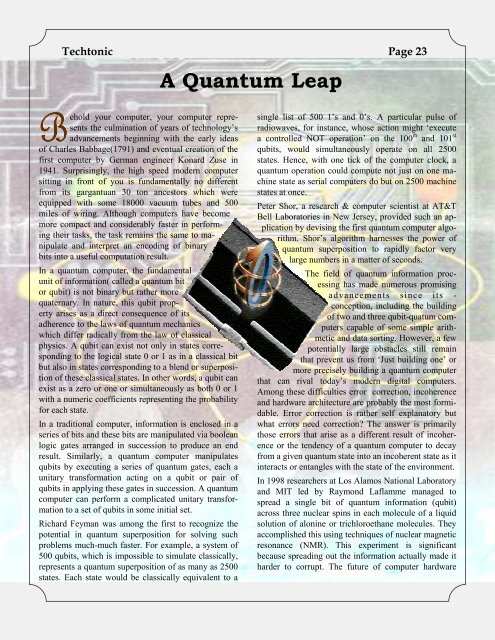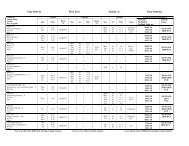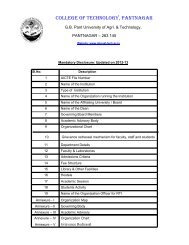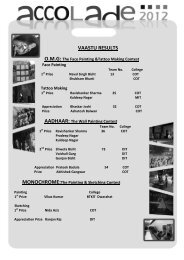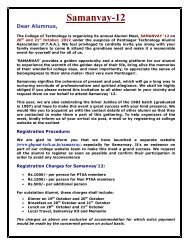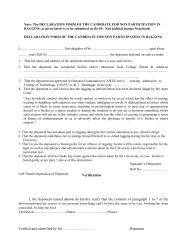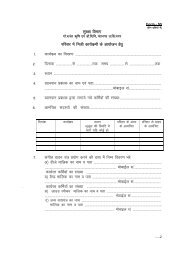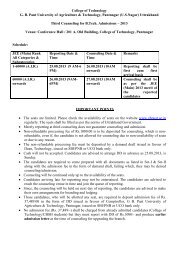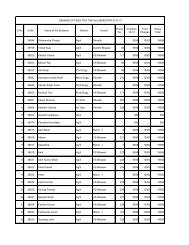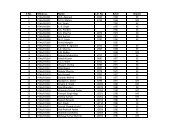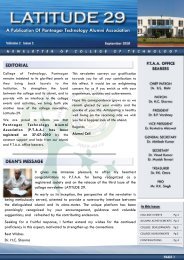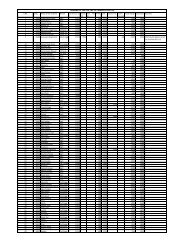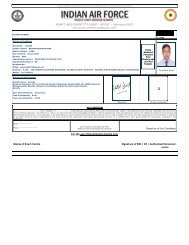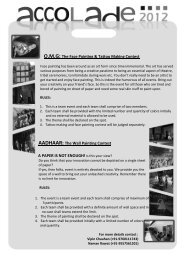Techniche 5th issue (Read-Only) - College of Technology, Pantnagar
Techniche 5th issue (Read-Only) - College of Technology, Pantnagar
Techniche 5th issue (Read-Only) - College of Technology, Pantnagar
You also want an ePaper? Increase the reach of your titles
YUMPU automatically turns print PDFs into web optimized ePapers that Google loves.
Techtonic Page 23<br />
B<br />
ehold your computer, your computer represents<br />
the culmination <strong>of</strong> years <strong>of</strong> technology’s<br />
advancements beginning with the early ideas<br />
<strong>of</strong> Charles Babbage(1791) and eventual creation <strong>of</strong> the<br />
first computer by German engineer Konard Zuse in<br />
1941. Surprisingly, the high speed modern computer<br />
sitting in front <strong>of</strong> you is fundamentally no different<br />
from its gargantuan 30 ton ancestors which were<br />
equipped with some 18000 vacuum tubes and 500<br />
miles <strong>of</strong> wiring. Although computers have become<br />
more compact and considerably faster in performing<br />
their tasks, the task remains the same to manipulate<br />
and interpret an encoding <strong>of</strong> binary<br />
bits into a useful computation result.<br />
In a quantum computer, the fundamental<br />
unit <strong>of</strong> information( called a quantum bit<br />
or qubit) is not binary but rather more<br />
quaternary. In nature, this qubit property<br />
arises as a direct consequence <strong>of</strong> its<br />
adherence to the laws <strong>of</strong> quantum mechanics<br />
which differ radically from the law <strong>of</strong> classical<br />
physics. A qubit can exist not only in states corresponding<br />
to the logical state 0 or 1 as in a classical bit<br />
but also in states corresponding to a blend or superposition<br />
<strong>of</strong> these classical states. In other words, a qubit can<br />
exist as a zero or one or simultaneously as both 0 or 1<br />
with a numeric coefficients representing the probability<br />
for each state.<br />
In a traditional computer, information is enclosed in a<br />
series <strong>of</strong> bits and these bits are manipulated via boolean<br />
logic gates arranged in succession to produce an end<br />
result. Similarly, a quantum computer manipulates<br />
qubits by executing a series <strong>of</strong> quantum gates, each a<br />
unitary transformation acting on a qubit or pair <strong>of</strong><br />
qubits in applying these gates in succession. A quantum<br />
computer can perform a complicated unitary transformation<br />
to a set <strong>of</strong> qubits in some initial set.<br />
Richard Feyman was among the first to recognize the<br />
potential in quantum superposition for solving such<br />
problems much-much faster. For example, a system <strong>of</strong><br />
500 qubits, which is impossible to simulate classically,<br />
represents a quantum superposition <strong>of</strong> as many as 2500<br />
states. Each state would be classically equivalent to a<br />
A Quantum Leap<br />
single list <strong>of</strong> 500 1’s and 0’s. A particular pulse <strong>of</strong><br />
radiowaves, for instance, whose action might ‘execute<br />
a controlled NOT operation’ on the 100 th and 101 st<br />
qubits, would simultaneously operate on all 2500<br />
states. Hence, with one tick <strong>of</strong> the computer clock, a<br />
quantum operation could compute not just on one machine<br />
state as serial computers do but on 2500 machine<br />
states at once.<br />
Peter Shor, a research & computer scientist at AT&T<br />
Bell Laboratories in New Jersey, provided such an application<br />
by devising the first quantum computer algorithm.<br />
Shor’s algorithm harnesses the power <strong>of</strong><br />
quantum superposition to rapidly factor very<br />
large numbers in a matter <strong>of</strong> seconds.<br />
The field <strong>of</strong> quantum information processing<br />
has made numerous promising<br />
advancements since its -<br />
conception, including the building<br />
<strong>of</strong> two and three qubit-quatum computers<br />
capable <strong>of</strong> some simple arithmetic<br />
and data sorting. However, a few<br />
potentially large obstacles still remain<br />
that prevent us from ‘Just building one’ or<br />
more precisely building a quantum computer<br />
that can rival today’s modern digital computers.<br />
Among these difficulties error correction, incoherence<br />
and hardware architecture are probably the most formidable.<br />
Error correction is rather self explanatory but<br />
what errors need correction? The answer is primarily<br />
those errors that arise as a different result <strong>of</strong> incoherence<br />
or the tendency <strong>of</strong> a quantum computer to decay<br />
from a given quantum state into an incoherent state as it<br />
interacts or entangles with the state <strong>of</strong> the environment.<br />
In 1998 researchers at Los Alamos National Laboratory<br />
and MIT led by Raymond Laflamme managed to<br />
spread a single bit <strong>of</strong> quantum information (qubit)<br />
across three nuclear spins in each molecule <strong>of</strong> a liquid<br />
solution <strong>of</strong> alonine or trichloroethane molecules. They<br />
accomplished this using techniques <strong>of</strong> nuclear magnetic<br />
resonance (NMR). This experiment is significant<br />
because spreading out the information actually made it<br />
harder to corrupt. The future <strong>of</strong> computer hardware


